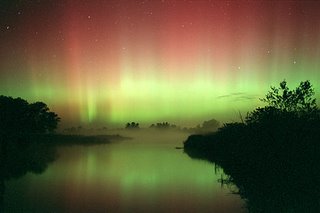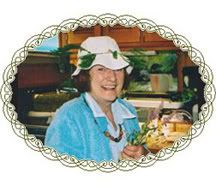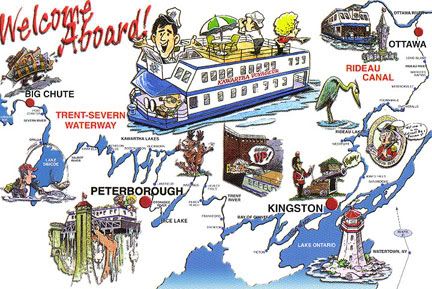
Depth of water that’s guaranteed in the waterway is 5’ and it could be ‘slightly’ shallower if the channels silt up over the course of the summer That precludes any deep-keeled sailing vessels travelling down it. The boat we have is a sailing trawler and it drafts 2’6”. The mast is on a pivot and is easy for two people to raise and lower, which makes it ideal for inland waterways. Because it's trailerable, we can drive right to wherever we would like to begin our trip.
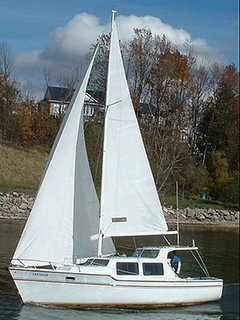
-----
Lock #1 is at Trenton, Ontario, Lake Ontario. It meanders in a westerly direction to Lake Simcoe, then turns north and ends at the northern gateway of Port Severn, Ontario on Georgian Bay, Lake Huron.
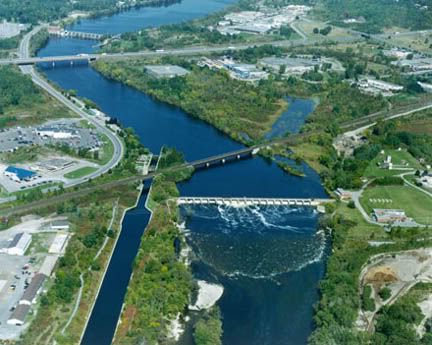
The system is 386KM long (a little over 230 miles).
Cultural Heritage:
Successive groups of Native people have travelled the natural waterway formed by the Waterway Lakes since at least 9000 B.C. Around the 17th century, the waters of what is now the Trent-Severn Waterway were a significant transportation route for fur traders. It began with a small wooden lock in 1833 in the Kawarthas at Bobcaygeon.
The system was intended as an alternative routing for goods for shallow-drafted boats, barges and ships. It didn’t become navigable until 1920—making it 87 years from start to completion. When it became usable, the Welland Canal had been built that connected Lake Erie with Ontario and the Saint Lawrence Seaway.
Large ocean-going and lake freighters were now able to sail into all the Great Lakes. That access made The Trent Severn obsolete for commercial vessels.
The Trent Severn Waterway has been classified as natural heritage and was declared a national historical site under the aegis of Parks Canada. Currently, it’s managed by the Friends of the Trent Severn Waterway.
More of its history
The story is quite fascinating. You’ll find diaries of Richard Birdsall Rogers 1874-1915, one of the leading engineers, the hardships he faced, the scandals, the disappointments, the financial obstacles, escalating costs and ultimately his vindication.
Not many people realize the Murray Canal is part of the Trent Severn:

The canal was built to provide an alternative shipping route to the treacherous waters surrounding Prince Edward county. Murray Canal has a depth 9 feet and is 5 miles long joining Presqu'ile Bay with the Bay of Quinte and is restricted by three swing bridges.
Swing Bridge, Murray Canal, Brighton, Ontario

Carrying Place Swing Bridge, Murray Canal:
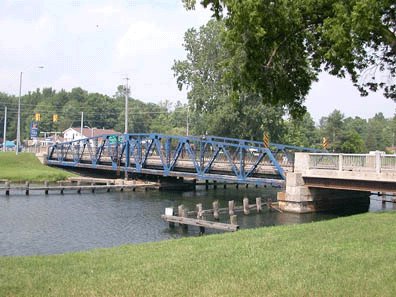
The present system is 36 conventional locks, 2 sets of flight locks, two of the highest hydraulic lift locks in the world, and a marine railway are all part of it.
Trenton, Ontario is also the site of Canadian Forces Base (CFB) Trenton. If you have a military frame of mind, you can read the Message from the Wing Commander.
(I do apologize for making this introuction so long, but to me, the Trent Severn Waterway is steeped in history).
Just before we begin our trip, let's take a look at a map of all the locks we'll be passing through to get from Trenton, Lake Ontario to the westerly destination of Port Severn, on Georgian Bay, Lake Huron:
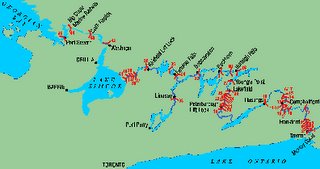
-----
Map in hand, now let's set off on our trip:
Lock #1: in suburban Trenton, Ontario:
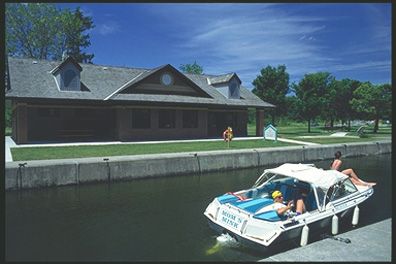
Locks 11 & 12 Ranney Falls Flight Lock:
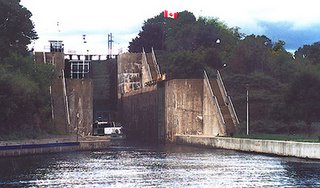
Locks #16 & 17 Healey Falls, Flight Lock:
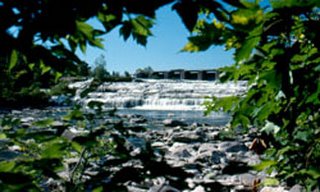
where within walking distance is an excellent site for viewing the Trenton and Black River limestone formations. Located along the Trent River, these exquisite falls (during high water flow) consists of a rugged series of wide steps.

Lock #20 Ashburnham:
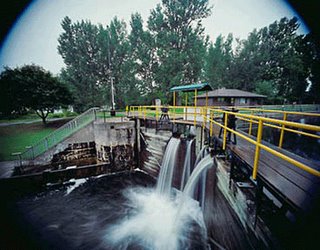
Lock #21 – Peterborough Lift Lock:
It opened July 9, 1904 and after 100 years, it’s still functioning. It’s an engineering marvel.
Here are a couple of golden oldie photographs of the Peterborough Liftlock on the opening day of what was then called, ‘The Trent Canal’, 1904:

Waiting for a Steamer above the lock:

One chamber lowering as the other rises:
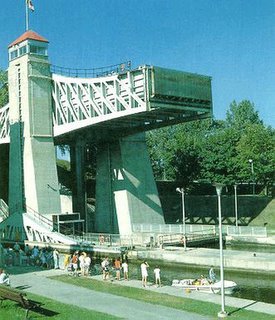
This lock works on the same principle as the Kirkfield Liftlock, and the chambers have the same dimensions. The drop here is 65 feet, making it the world’s highest liftlock by 15 feet. In 1999, the Peterborough Hydraulic Lift Lock became the first Canadian site to be designated by the American Society of Mechanical engineers as an International landmark.
Here's some boats being raised:
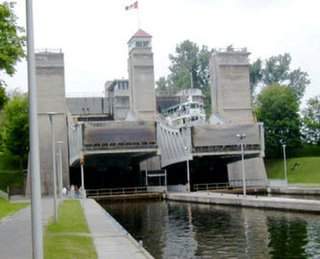
Trent University, Peterborough; a tranquil canal near the university:
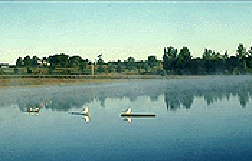
We tied up not far from the University and went for a walk to the downtown area, picked up some lunch and ate it on park benches and watched the boats going by. Above us were a wide variety of colourful blooms from hanging baskets. Casual, bright, summer flowerbeds dotted the landscape. There were numerous wild birds swimming in the canal, which we fed with leftovers. In no really hurry, we meandered upstream to the next lock.
-----
A few of these pictures, I may have out of order, because I've forgotten their exact locations. I do know these are all in the area of the Kawartha’s/Muskoka’s (It’s a very popular resort-type area of Northern Ontario, because of its natural beauty and charming little towns). It’s also called, “Cottage Country” by residents of Toronto who don’t have to drive very far to escape from suburbia. There are hundreds of lakes in the Muskoka’s and boaters tend to seek the secluded areas. The nautical term for it is, “gunkholing” similar to what is done in the North Channel where boats don’t dock at marinas. The anchor is just set into the bottom and the bow is tied to a tree or a large rock water. Most of the bottom is mud, sand or gravel, and it's very easy to set anchors as opposed to the North Channel where it's granite rock.
Muldrew Lake, Muskokas:

Morning Mist on Muldrew Lake:
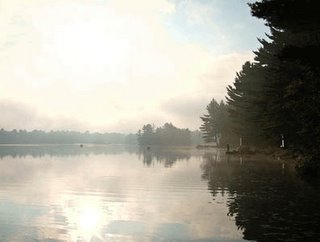
Fall picture of Long Lake, Muskokas:
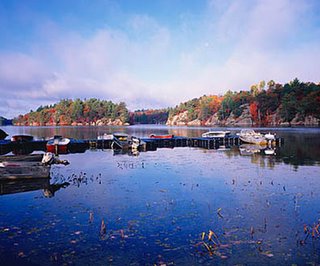
Lock #28 Burleigh Falls rapids:
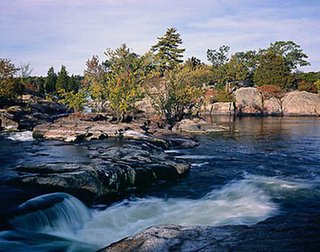
Lock #31 Buck Horn Lake, not far from it is the Three Castles Resort:
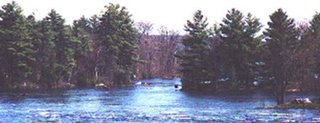
Buckhorn Lake: You could spend weeks in each place and not run out of things to admire.
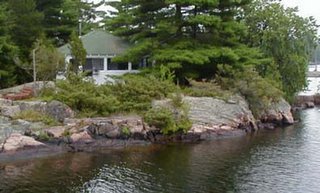
There was a lightning storm that caused a power failure at the Buckhorn Lock. We stayed there overnight, tied to the wall. An man and his companion rafted off our stern. They had one of those round ‘pup’ tents which they struggled to erect. We had to go below to muffle our laughter watching their antics trying to put it up. It was obvious it had been quite some time since either of them had been boy scouts! :) It was a fun night, because there were quite a few of us rafted up together in the lock. Someone started playing a guitar and impromptu singers joined in the merriment. The two men with the tent finally got it up just before we went to bed.
A great herd of boats didn’t develop the next morning that all wanted to exit at the same time. The departing out of the lock was quite orderly. The fees were waived for everyone for the overnight dockage. The people who operate the locks are friendly and very accommodating. At one place, we were getting low on brewskie's, and the man at the lock drove us to the beer store because we were his only customer. In addition to washrooms at the locks, there are quite often BBQ's that boaters share. If anyone else is there, usually a friendly exchange takes place.
-----
Lock #32 Bobcaygeon: pastureland
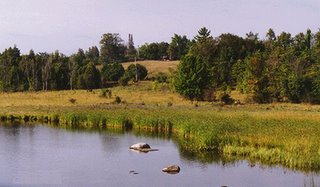
Fall picture of the channel at Bobcaygeon:
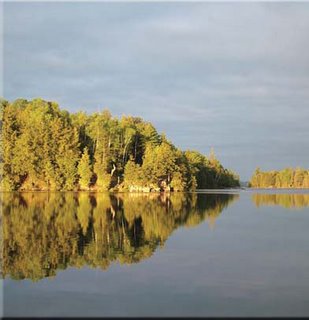
Locking the logs, circa 1900's:
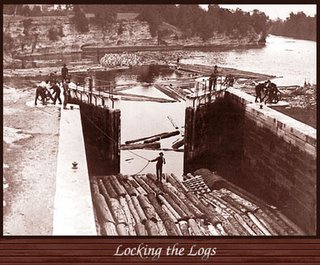
Bobcageon Sentinel Pine watching over a lake:
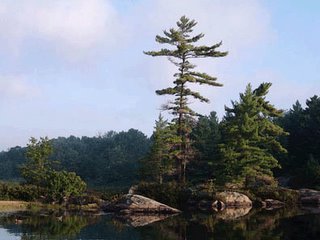
-----
Lock #33, Lindsay, Ontario (not shown.)
We went to see a play at the Academy Theatre, what a beautiful theatre it is, very baroque. You wouldn't think there would be such a lovely place in such a small community. But there are many small communities that do have marvelleous summer stock theatres where plays and musicals are done with great expertise. Most employ professional actors, actresses, singers and dancers that are supplemented with local talent. The productions are usually well-worth seeing. I can’t ever recall being disappointed with any we’ve attended. Lots of other towns if they don’t have a theatre; they’ll have summer festivals in their villages or towns; strawberry suppers & socials are alive and well in small towns. We sometimes go to the Stratford Festival, about 40 miles away from us where there are world-class Shakespearean productions.
-----
Lock #34 Fenelon Falls, circa 1930:
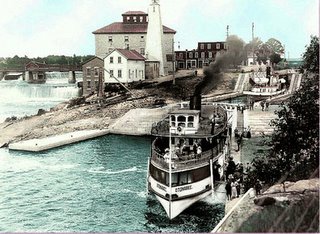
The falls at Fenelon Falls:
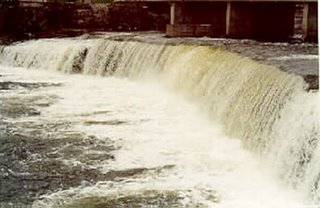
The approach to locks are before dams and falls, which is the reason locks are built so boats could bypass navigational hazards.
Fenelon Falls sunset:
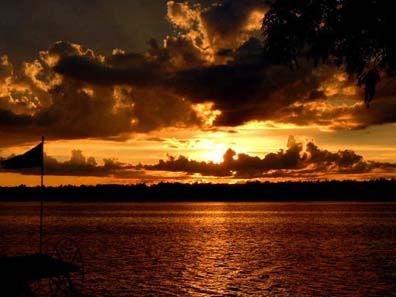
-----
Lock #36 Kirkfield Liftlock (Balsam Lake):
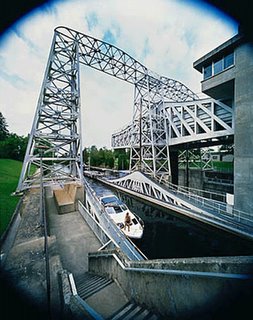
Assent is 49’, 2nd highest liftlock
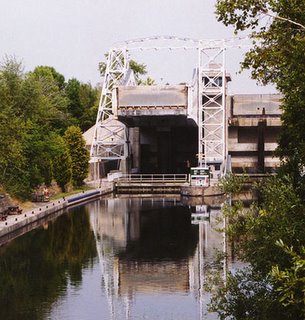
The concept of this liftlock and the Peterborough Liftlock were derived from liftlocks built in England, Belgium and France in the 1870s and 1880s. The Trent Canal Superintending Engineer, Richard B. Rogers felt that due to their geographic locations, both sites would benefit from a lift, as opposed to the conventional lock. Water conservation, cost, and lockage time were all contributing factors. Originally, Rogers envisioned cargo transportation on the Waterway being done by using strings of five to twelve barges towed by a single vessel.
Another thing that's interesting about this lock is that Balsam Lake is the summit of the Trent Severn Waterway. Probably doesn't mean a lot unless you're navigating. But when a waterway such as this reaches its peak, the flow of water changes directions. Aids to navigation in North America are usually lateral systems and are based on the direction the water is moving, or put another way, from the direction of the flood tide or an approach from seaward. (Red Right Returning is something most navigators drill into themselves very early in their training). After Kirkfield, marks that were previously left to one side are now left on the other. The way to remember which side aids are supposed to be left on, is that upstream: red markings or lights, even-numbered or pointed markers or buoys, are left on the starboard (right) side. Boats, especially sailboats, don't usually travel quickly so there usually is time to adjust to which side it is meant for them to left! :)
-----
Lake Simcoe: a largish fresh water lake, lies between the locks--stocking the lake with whitefish and lake trout:
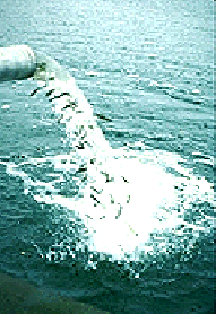
-----
Orillia, on the mainland off Lake Simcoe
Orillia is perhaps better known as the home of Canada’s premiere humorist Stephen Leacock. He wrote of people and events in Orillia with a razor-sharp wit, and a sense of the ‘funny side of life’. His book, Sunshine Sketches of a Little Town was produced from these observations of his home town.
Orillia, at the "Flock and Drover":

Leacock was head of the department of Political Science and Economics at McGill University in Montreal, and became a world famous author and lecturer. In his lifetime he wrote 62 books; 35 of which were humorous, the rest being scholarly texts on economics and political science.
One of my favourite short stories Leacock wrote was, “My Financial Career” What I like most about Leacock's writings was they were never mean-spirited. His brand of humour wasn't satirical. He was a master of irony and good-natured understatement.
Somehow I don’t think Leacock would have approved of replacing paper dollars with 'Loonies and Toonies'! What a great story he’d be able to make up about those heavy coins that tear your pockets and weigh down the jeans of men making their pants sag! That’s the only reason I can think of for wearing them so low that the crotches drag on the ground. If they had to run away from an attacker with a paring knife, they’d be goners!
Loonies and Toonies:

He undoubtedly would have laughed heartily at the new quarter that was designed by 11-year-old Nick Wooster. I’ve dubbed it the 'Moosie':

Oh, I do hope no government official is reading this blog, because that would inspire them to use that design to start minting a replacement for our five dollar bill!

-----
-----
Oops, I forgot to mention that in Buckhorn, we did hear the loons singing in the evening. But I didn’t get any pictures of them because there were too many boats and people for them to come close enough.
-----
Sparrow Lake, on the way to the Swift Rapids Lock:
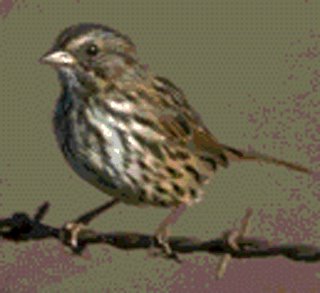
Rock Island Bird Sanctuary, Sparrow Lake:

Pink Clouded Twilight on Sparrow Lake:

Swift Rapids, Lock #43:
Swift Rapids Dam and Power Station
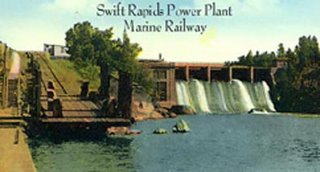
Coming up to Lock #44 in the early morning:

Lock #44: Big Chute Marine Railway Lock
Artist’s watercolour rendition of the Big Chute Marine Railway:
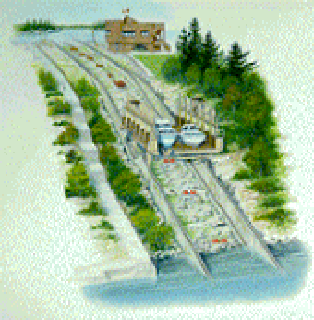
This is where the Severn River rushes through a narrow chute of pre-Cambrian granite. A marine railway has been in operation since 1917. Today's giant-sized carriage and tracks were installed adjacent to the still-operational smaller railway in 1977. Although replacing the marine railway with a conventional lock would have been simpler, the land portage over the 17.7 meter height of land was necessary to prevent the possible migration of the parasitic sea lampry into the Lake Simcoe fishery.
Actual picture of the Railway lock:
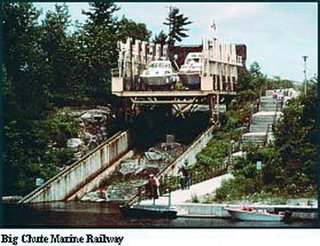
Lower Severn River:
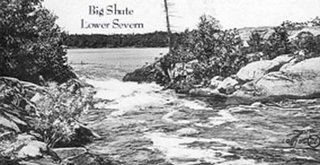
View from a boat being transported in the railway lock:
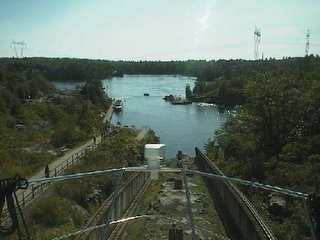
Port Severn, Lock #45, last one:
Bit of background about Port Severn, which like many other small villages and towns on the Trent Severn were logging communities.
I have no axe to grind with logging companies or their owners that dominated them. What they did probably profited the towns and villages, but like always only infestimal amounts were for the benefit of the workers.
Honey Harbour, Port Severn, aerial view of the gateway to the Trent Severn Waterway from Georgian Bay, Lake Huron:
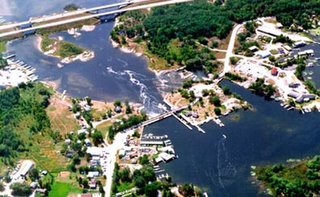
-----
All tied up ‘til the next trip. Would we ever do the Trent Severn again? “You betcha!” Extraordinary trip, hundreds of more gunkoling places, and things we haven’t done or seen before.
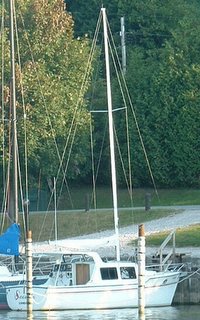
On the next trip, we might even be treated to the rare splendor of the Northern Lights (Aurora Borealis) on a night when the skies are inky enough.
